This was fairly tricky, I found two solutions: create one facet for the positive opinions and one for the negative ones, and removing the space between the facets; explicitly define the start and end for each bar and passing that to geom_segment instead of geom_col.
Common part
Independently from which method you prefer, there are lots of common things:
The first thing you asked was to stack together the bars for different occasions. That can be done by adding position = "dodge" or "dodge2" inside geom_...; Or by creating a new y axis by doing paste(item, "- Occasion", occasion). The first option is more elegant, but i couldn't get it to work.
First step: create the new y axis, and transform number into a frequency (so that the x axis goes form -100% to 100%):
all.gg.data2 = df %>%
mutate(item2 = paste(item, "- Occasion", occasion)) %>%
group_by(item, occasion) %>%
mutate(number = number / sum(number))
Second step: as we want N to be centered in zero, divide that opinion in half, the "positive part", and the "negative part"
all.gg.data.N = all.gg.data2 %>%
filter(opinion == "N") %>%
{rbind(mutate(., number = number/2, opinion = "N-"),
mutate(., number = number/2, opinion = "N+"))}
Third step: add the new N rows, create the scale variable, and transform the number column depending by what method we want. Fourth step: plotting. Now i divide the explanation by methods.
Obs: both use the custom function (based on scales::wrap_format) that removes extra text from the y axis:
my_wrap_format = function(x) {
x[seq(2, length(x), 2)] = gsub(".+(- Occasion [1-2])", "\\1", x[seq(2, length(x), 2)])
unlist(lapply(strwrap(x, width = 50, simplify = FALSE),
paste0, collapse = "\n"))}
Faceted geom_col method
Third step: change the sign of number for the negative part.
all.gg.data = all.gg.data2 %>%
filter(opinion != "N") %>%
rbind(all.gg.data.N) %>%
mutate(opinion = factor(opinion, levels = c("SD", "D", "N-", "SA", "A", "N+")),
scale = ifelse(opinion %in% c("SD", "D", "N-"), "-", "+"),
number = ifelse(scale == "-", -number, number))
Fourth step: create facets based on scale (facet_wrap(vars(scale))), remove extra space in the x axis (expand = c(0, 0) and panel.spacing = unit(0, "cm")), and join "N+" and "N-" with scale_fill_manual.
ggplot(all.gg.data, aes(x = number, y = item2, fill = opinion)) +
geom_col() +
facet_wrap(vars(scale), ncol = 2, scales = "free_x") +
scale_y_discrete(labels = my_wrap_format) +
scale_x_continuous(labels = scales::percent, expand = c(0, 0)) +
labs(title = "Opinion", subtitle = "Subtitle", x = "Percentage", y = "", color = "") +
scale_fill_manual(values = c(SD = "darkblue", D = "blue", `N-` = "grey",
`N+` = "grey", A = "red", SA = "darkred"),
labels = c("SD", "D", "N", "A", "SA"),
breaks = c("SD", "D", "N-", "A", "SA")) +
theme(panel.spacing = unit(0, "cm"),
strip.text = element_blank(),
strip.background = element_blank())
Result:

geom_segment method
Third step: define the x and xend aesthetics for geom_segment. xend was created by summing the number values with purrr::accumulate, but in one direction for the positive scale, and the other for the negative. x was created by the lag of xend and a different starting point for each scale.
my_accumulate = function(number, scale) {
accumulate(number*ifelse(scale == "-", -1, 1), sum, .dir = ifelse(scale[1] == "-", "backward", "forward"))}
all.gg.data = all.gg.data2 %>%
filter(opinion != "N") %>%
rbind(all.gg.data.N) %>%
mutate(opinion = factor(opinion, levels = c("SD", "D", "N-", "N+", "A", "SA")),
scale = ifelse(opinion %in% c("SD", "D", "N-"), "-", "+")) %>%
arrange(item, occasion, opinion) %>%
group_by(item, occasion, scale) %>%
mutate(number = my_accumulate(number, scale),
numberStart = if(scale[1] == "-") {c(stats::lag(number, -1)[-1], 0)} else {c(0, stats::lag(number)[-3])})
Obs: you can think that explicitly defining the start and ending points for each bar was automatically done by geom_col, that's why this method is larger.
Fourth step: join "N+" and "N-" with scale_color_manual.
ggplot(all.gg.data, aes(x = numberStart, xend = number,
y = item2, yend = item2, color = opinion)) +
geom_segment(size = 2) +
scale_y_discrete(labels = my_wrap_format) +
scale_x_continuous(labels = scales::percent) +
labs(title = "Opinion", subtitle = "Subtitle", x = "Percentage", y = "", color = "") +
scale_color_manual(values = c(SD = "darkblue", D = "blue", `N-` = "grey",
`N+` = "grey", A = "red", SA = "darkred"),
labels = c("SD", "D", "N", "A", "SA"),
breaks = c("SD", "D", "N-", "A", "SA"))
Result:

Appendix: full code
geom_segment method:
my_wrap_format = function(x) {
x[seq(2, length(x), 2)] = gsub(".+(- Occasion [1-2])", "\\1", x[seq(2, length(x), 2)])
unlist(lapply(strwrap(x, width = 50, simplify = FALSE),
paste0, collapse = "\n"))}
my_accumulate = function(number, scale) {
accumulate(number*ifelse(scale == "-", -1, 1), sum, .dir = ifelse(scale[1] == "-", "backward", "forward"))}
all.gg.data2 = df %>%
mutate(item2 = paste(item, "\n- Occasion", occasion)) %>%
group_by(item, occasion) %>%
mutate(number = number / sum(number))
all.gg.data.N = all.gg.data2 %>%
filter(opinion == "N") %>%
{rbind(mutate(., number = number/2, opinion = "N-"),
mutate(., number = number/2, opinion = "N+"))}
all.gg.data = all.gg.data2 %>%
filter(opinion != "N") %>%
rbind(all.gg.data.N) %>%
mutate(opinion = factor(opinion, levels = c("SD", "D", "N-", "N+", "A", "SA")),
scale = ifelse(opinion %in% c("SD", "D", "N-"), "-", "+")) %>%
arrange(item, occasion, opinion) %>%
group_by(item, occasion, scale) %>%
mutate(number = my_accumulate(number, scale),
numberStart = if(scale[1] == "-") {c(stats::lag(number, -1)[-1], 0)} else {c(0, stats::lag(number)[-3])})
ggplot(all.gg.data, aes(x = numberStart, xend = number,
y = item2, yend = item2, color = opinion)) +
geom_segment(size = 10) +
scale_y_discrete(labels = my_wrap_format) +
scale_x_continuous(labels = scales::percent) +
labs(title = "Opinion", subtitle = "Subtitle", x = "Percentage", y = "", color = "") +
scale_color_manual(values = c(SD = "darkblue", D = "blue", `N-` = "grey",
`N+` = "grey", A = "red", SA = "darkred"),
labels = c("SD", "D", "N", "A", "SA"),
breaks = c("SD", "D", "N-", "A", "SA"))
Faceted geom_col method:
all.gg.data2 = df %>%
mutate(item2 = paste(item, "\n- Occasion", occasion)) %>%
group_by(item, occasion) %>%
mutate(number = number / sum(number))
all.gg.data.N = all.gg.data2 %>%
filter(opinion == "N") %>%
{rbind(mutate(., number = number/2, opinion = "N-"),
mutate(., number = number/2, opinion = "N+"))}
all.gg.data = all.gg.data2 %>%
filter(opinion != "N") %>%
rbind(all.gg.data.N) %>%
mutate(opinion = factor(opinion, levels = c("SD", "D", "N-", "SA", "A", "N+")),
scale = ifelse(opinion %in% c("SD", "D", "N-"), "-", "+"),
number = ifelse(scale == "-", -number, number))
ggplot(all.gg.data, aes(x = number, y = item2, fill = opinion)) +
geom_col() +
facet_wrap(vars(scale), ncol = 2, scales = "free_x") +
scale_y_discrete(labels = my_wrap_format) +
scale_x_continuous(labels = scales::percent, expand = c(0, 0)) +
labs(title = "Opinion", subtitle = "Subtitle", x = "Percentage", y = "", color = "") +
scale_fill_manual(values = c(SD = "darkblue", D = "blue", `N-` = "grey",
`N+` = "grey", A = "red", SA = "darkred"),
labels = c("SD", "D", "N", "A", "SA"),
breaks = c("SD", "D", "N-", "A", "SA")) +
theme(panel.spacing = unit(0, "cm"), panel.border = element_blank(),
strip.text = element_blank(), strip.background = element_blank())



